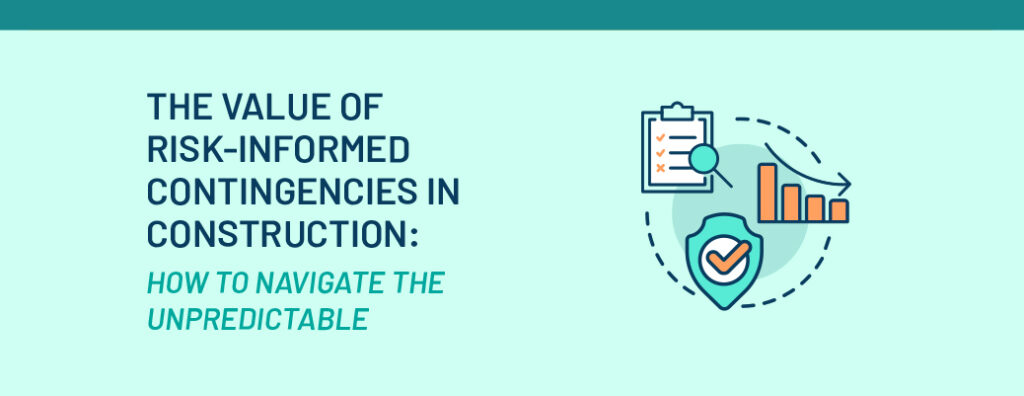
Imagine preparing for a marathon. You’ve diligently mapped out your route, trained for months, and perfected your pace. On race day, you are feeling confident, but halfway through, an unexpected obstacle arises—fatigue, a cramp, or unanticipated weather conditions. Without a backup plan, what began as a controlled race could quickly turn into a frustrating setback.
The same principle applies in construction. Initially, everything may appear to be running smoothly. Budgets are established, schedules are set, and designs are finalized. However, as the project progresses, unforeseen challenges inevitably emerge, such as changes in scope, unforeseen site conditions, material shortages, or rising costs. By anticipating potential risks and assessing the likelihood and impact of each, you can adjust your approach proactively so that the project stays on track and momentum is maintained.
What Are Risk-Informed Contingencies?
Construction cost contingency has traditionally been calculated as a percentage of the total project cost, typically ranging from 5% to 15% at the time of bidding, to address unforeseen risks. Construction schedule contingency is often ignored, with formal schedule contingency activities rarely being added to project execution schedules. This approach fails to give the appropriate level of attention to the inevitable risks and uncertainties that affect project objectives and lacks the precision needed for modern, complex projects. The result is projects delivered late, over budget, and with reduced value from what was identified when the project was approved.
Using an alternative approach, risk-informed contingencies are derived from project-specific risk assessments. These assessments enable project teams to anticipate and account for potential obstacles more effectively, which in turn helps reduce impacts on project objectives and protect project value.
Risks and Uncertainties
Risk-informed contingency planning starts with differentiating between project risks and project uncertainties.
Risks are discrete events or conditions with a probability of less than 100% occurrence, such as design errors, permitting delays, or potential scheduling conflicts. Because they may or may not happen, they are typically captured in a risk register and modeled as probabilistic events in cost and schedule analysis.
Uncertainties, on the other hand, are elements of the project that will definitely influence outcomes, but the degree of impact is unknown. Examples include variability in labor productivity, fluctuations in material prices, or the number of weather delay days within a normal season. These factors are modeled as ranges or probability distributions, since the question is not if they will occur but how much they will affect project objectives.
Instead of ignoring the influences of risk and uncertainty on project cost and time estimates, teams can identify specific risks and uncertain factors to be assessed. Project teams then use historical data, risk analysis tools, and predictive modeling to assess their likelihood and impact. Identifying these elements and using probabilities and ranges of impacts rather than point value estimates makes it easier to quantify and plan for their potential effects on the project.
While it may seem like a win to show a better cost or schedule at the beginning of a project without carrying adequate contingency to cover these risks, timely and well-thought-out risk-informed cost and schedule contingency could ultimately save the project from financial issues and unwanted time impacts. Different stakeholder perspectives can also pose some risk. Owners, contractors, and designers often individually prioritize other aspects of a project, such as cost control, practicality, and technical feasibility. Without collaboration, these differing priorities can lead to conflicting assumptions about risk, creating gaps in the risk assessment and contingency planning processes. The project team must look collectively at the overall project and its potential risks.
Thinking back to the marathon analogy, each runner enters the race with their own strategy, whether focused on pacing, hydration, or nutrition. Similarly, project stakeholders bring unique perspectives. By combining these viewpoints and with transparent communication, teams can develop a more comprehensive understanding of the risks, leading to a more realistic and effective contingency plan.
The Role of Timely Decision-Making in Risk Management
In addition to data-driven insights and planning, timely decision-making is crucial in managing project risks. When faced with unforeseen challenges, such as a delay in material delivery or a sudden change in site conditions, the quicker the team can make informed decisions, the better they can mitigate the impact.
Delays in decision-making can cause risks to snowball, leading to missed opportunities for course correction and unnecessary cost overruns. This is where collaboration and clear communication among stakeholders come into play. Ensuring that decisions are made efficiently and everyone is aligned helps avoid delays and keeps the project moving forward.
Using Historical Data to Inform Risk and Contingency Planning
Predicting risk events and uncertainties can be complex, but leveraging historical data is one of the most effective tools for addressing them. By analyzing projects with similar scopes, site conditions, and delivery methods, teams can create more accurate risk models and forecasts for new projects. Historical data allows teams to understand past risk behaviors and anticipate potential disruptions before they occur, improving contingency development.
For example, the Federal Transit Administration (FTA) has extensive datasets covering U.S. transit projects over several decades [https://www.transit.dot.gov/capital-cost-database]. These datasets are categorized by key attributes such as mode of transportation, location at-grade, underground, or aerial, new, extension, or rehabilitation, project elements, size, and capital costs. These datasets enable teams to derive historical, data-informed cost structures and schedules.
By understanding how similar projects have evolved, teams can build more realistic forecasts for new projects based on real-world scenarios. This is especially important when comparing your project to datasets from other agencies or even international projects. While this broadens the perspective, the critical factor is tailoring the historical data to the unique aspects of your current project. Variables such as the project’s size, scope, delivery method, and regulatory environment must all be considered and integrated into the forecast for reliability.
Best Practices for Navigating Supply Chain Disruptions and Material Price Volatility
One of the most persistent challenges is the unpredictability of material prices and supply chain disruptions, and risks increase with the duration of a project. From global trade issues to unplanned events like a pandemic, the availability of essential materials has become increasingly unpredictable. Proper contingency planning must factor in these variables to safeguard the project’s financial stability.
Here are five recommended best practices:
- Proactively monitor market conditions and trends for materials and labor to address potential issues promptly.
- Consider economic price adjustment contract provisions and include an allowance in the estimate to fund this. Many projects with durations longer than three years and with significant quantities of materials that typically fluctuate in price with the economy, such as steel, concrete, petroleum-based products, and copper, usually have economic price adjustments built into the contract to allow for adjustments upward and downward as the material costs change beyond an agreed threshold.
- Consider additional cost markups beyond standard escalation. While not typically a component of the construction cost estimate, an allowance to fund an economic price adjustment should be identified in the overall project budget. This budget amount should be appropriately quantified, addressing the likelihood and variability of potential impacts before assigning a line-item value. As such, while market price fluctuations are often treated as standard escalation, including this as additional cost markups may be necessary depending on the assumed risk. For example, many teams introduced a “COVID impact percentage” during the COVID pandemic to account for market shifts.
- Lock in prices for critical materials early. Another strategy that helps mitigate price volatility risk is securing critical materials early to lock prices.
- Have owner-purchased materials included in the contract. In cases involving highly specialized or custom items, one approach is for the owner to purchase the materials directly, locking in prices and often limiting schedule issues due to long lead times before the contractor begins the installation. While this can be controversial, it is an effective strategy to minimize risks associated with fluctuating material prices or supply shortages.
Collaboration and Communication: The Keys to Success
While not all risks can be predicted, thoughtful planning and clear and prompt communication provide a foundation for navigating the unpredictability of construction. By facilitating collaborative risk assessments that align all stakeholder perspectives, establishing risk-informed contingencies tailored to each project, equipping teams for rapid decision-making to address emerging challenges, and implementing targeted tactics to mitigate market volatility, project teams can protect budgets, maintain schedules, and deliver maximum value.
This integrated approach transforms risk management from a reactive exercise into a strategic advantage, ensuring projects remain resilient and on track despite the inevitable challenges of modern construction. Like in a marathon, the key to success is proactively addressing weaknesses, staying flexible and reactive to changing conditions, and keeping a clear focus on crossing the finish line.
Download a copy of this blog here.






